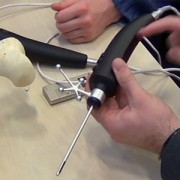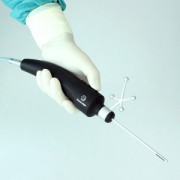A prototype – naturally. But in due time!
The use of prototypes in an innovation evaluation study must be done methodically and with care. Interview with Julien Soler, UX project manager at IXIADE concerning the medical imaging tool ChondroSight*.
The Grenoble start-up CARTIMAGE develops technologies for the detection and treatment of cartilage disorders. In early 2015, the start-up called upon IXIADE to evaluate and design an ultrasound probe prototype intended for arthroscopic surgeons for knee cartilage surgery. How best to test an idea… and a first prototype? Interview.
What was your first reaction to the prototype?
When Benoit Vettier (ed. President of CARTIMAGE) came to introduce us his ChondroSight project, we immediately spotted a great opportunity of support. It was the moment where our advice was the most relevant. The development and thinking on the object was well advanced, but it also left leeway that allowed the potential for substantial improvements. And at the same time, we felt that testing a prototype that had strong potential but was not fully completed ergonomically, aesthetically or was miniaturized on users would be risky. There is a risk of rejection that should not be underestimated because at times, the physical object we present to users prevents them from imagining what it may become. Therefore, we had to work without haste and think together on the best way to present the product to its future users. Our response then was to offer a study in two phases: 1/ an assessment of the concept, 2/ an assessment of the object/prototype.
What did this support consist of?
Firstly, our Design team conducted a meticulous analysis of the tools used currently by arthroscopic surgeons: shapes, materials, etc. This step allowed us to quickly offer the company an “ideal” non-mechanised prototype, primarily taking into account the constraints and trends connected to this highly specialised sector. At the same time, we have drafted together a presentation to communicate the innovation offered by CARTIMAGE. We also reflected on two analytical frameworks to carry out the study with future users. A first grid allows the assessment of the suitability of the concept thanks to the Cautic® method and another to assess the handling of the object. It is central to have thought about it in this sequence: we noticed it on several occasions in a number of projects and the feedback from the surgeons has confirmed it yet again.
In December 2015, after 4 weeks of joint work, we have organised a field study in a professional tradeshow which brought together a number of specialised surgeons in cartilage surgery. 17 French and foreign surgeons participated in the tests. At the end of these two days and a two weeks’ analysis, we produced two reports: one on the response to the concept and another concerning the handling of the object.
What is the advantage of this method?
A good idea is not enough. It is not because an object is perceived as being attractive or very ergonomic that it will necessarily have a good reception with the target market. Above all, the concept must find its place in a rich social environment which includes specific habits, codes and constraints. Here, being the first to test the concept without showing the concept allowed surgeons to project themselves with an open mind. I would even say that they were “back in the game” by suggesting their own ideas for improvement or imagining themselves using the object in a particular situation. Secondly, the presentation of the prototype gathered interesting remarks regarding the handling and the ergonomics.
How did potential users perceive this innovation?
They perceived it in a very positive manner on the whole because this object has real advantages even if it induces a change in the practice. Surgeons have greatly appreciated the manner in which the probe allows to objectify the analysis of the cartilage, so far subject to considerable interpretation. They promptly saw the advantage of using the tool, particularly in the case of surgeries with a lack of visibility.
But they mostly perceived it in an active and constructive manner. In other words, they imagined with us what could become the ideal tool starting with the concept then the prototype. And that is exactly what we wanted to achieve. In the end, the project is in development as a result of the tests that we conducted and the company is considering a market launch. This experiment shows us that in the context of a relevant user experience methodological approach, presenting a prototype is a real asset. However, presenting it too early may be an immediate ground for rejection since the object has a tendency to block the mental projection: therefore, you must handle with care.
 *ChondroSight is an optimised motorised probe which performs an ultrasound of the knee cartilage. It provides accurate and objective measures, a better visualisation and a more accurate diagnosis.
*ChondroSight is an optimised motorised probe which performs an ultrasound of the knee cartilage. It provides accurate and objective measures, a better visualisation and a more accurate diagnosis.




Leave a Reply
Want to join the discussion?Feel free to contribute!